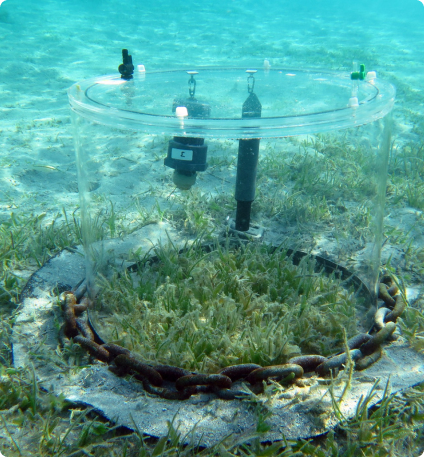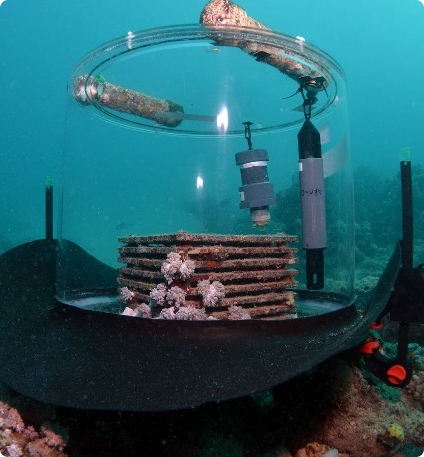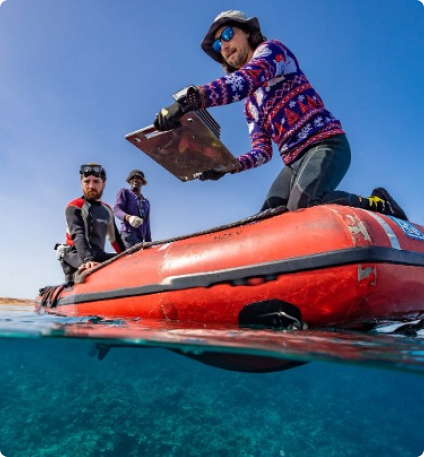Coral reefs are home to many small, obscure, and hidden taxa which traditional observational survey methods either cannot detect or under-report. This is due to the many small holes and crevasses found throughout coral reefs where they hide, as well as to the morphological similarity and camouflage of many small reef species. In order to address this shortcoming, we use Autonomous Reef Monitoring Structure (ARMS). These standardized devices mimic the complexity of the reefs, allowing for the non-destructive long-term collection cryptobenthic organisms including bacteria, invertebrates, and cryptic fish which otherwise are exceptionally difficult to sample using standard non-destructive methods. Together, these microbes and small invertebrates and fishes comprise the reef cryptobiome, the biological component that contributes the most to reef biodiversity.
Spatial and temporal changes: As of 2022, our team has retrieved more than 200 individual ARMS units across the Red Sea, Arabian Gulf and Gulf of Oman. Since 2014, we have retrieved and re-deployed ARMS units at many permanent reefs in the central Red Sea, which resulted in the first-ever time series of data of the cryptobiome across a latitudinal gradient, including both eukaryote and prokaryote communities. Our research showed significant community changes over time, particularly due to a coral bleaching event in 2015/2016. While larger organisms (>2mm) showed an increase in diversity post-bleaching, smaller organisms (<2mm) experienced a decline, only showing some signs of recovery four years after the bleaching. These findings highlight size-dependent responses of the reef cryptobiome and highlight the value and need to continuously monitor this “hidden majority”.
- Species distribution patterns: The cryptobiome community structure varies significantly along environmental gradients, such as sea surface temperature, photosynthetically active radiation (PAR), and benthic habitat characteristics (e.g., hard coral and turf algae cover). Higher temperatures and increased PAR are generally associated with greater species richness and abundance. Responses to environmental drivers vary, with certain taxa (e.g., arthropods and mollusks) being more sensitive to temperature and habitat changes. This suggests that increasing sea temperatures and habitat modifications may alter species composition and biodiversity. As we strive to better understand the cryptobiome and the function it serves in the larger macro-scale community and ecosystem, we continue to study and observe distribution patterns and processes.
- Ecosystem function: Only limited information is available about the contribution of cryptobenthic communities to wider reef function. To address this significant knowledge gap, we have been incubating ARMS in situ using custom-designed chambers to examine the cryptobiome’s contribution to nitrogen and carbon cycling and reef calcification. This research marks the first assessment of cryptobiome biogeochemical functions via ARMS, establishing a framework that can be applied within the ARMS Global Project and other ARMS initiatives worldwide to enhance understanding of the dynamics and functional roles of this essential biodiversity component in coral reef ecosystems.
- Environmental DNA: Environmental DNA, or eDNA, is the genetic material that can be obtained from environmental samples such as water or sediment without isolating the organism. The use of eDNA provides a powerful tool for elucidating the diversity within the reef cryptobiome collected via ARMS. By extracting DNA from the different fractions (i.e. larger organisms (>2mm), and smaller organisms (<2mm)) of the ARMS, we identify a wide range of taxonomic groups. Even after collection and sorting, many of these small cryptic species may be difficult to identify due to morphological similarities or due to their fragility. Thus this approach enhances the resolution of biodiversity data, offering insights into community composition and functional roles, and complements physical specimen identification, thus advancing our understanding of cryptobenthic communities.






